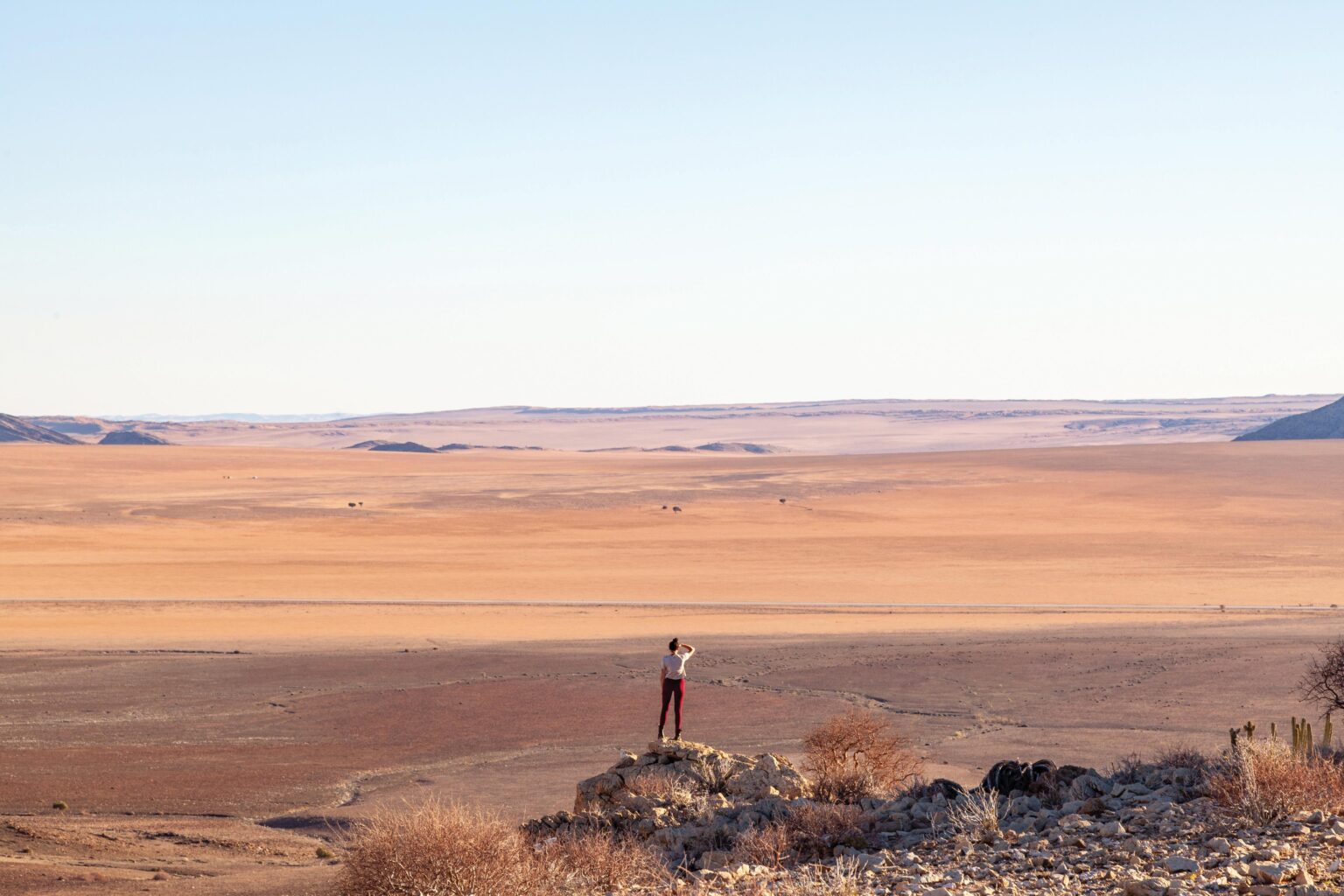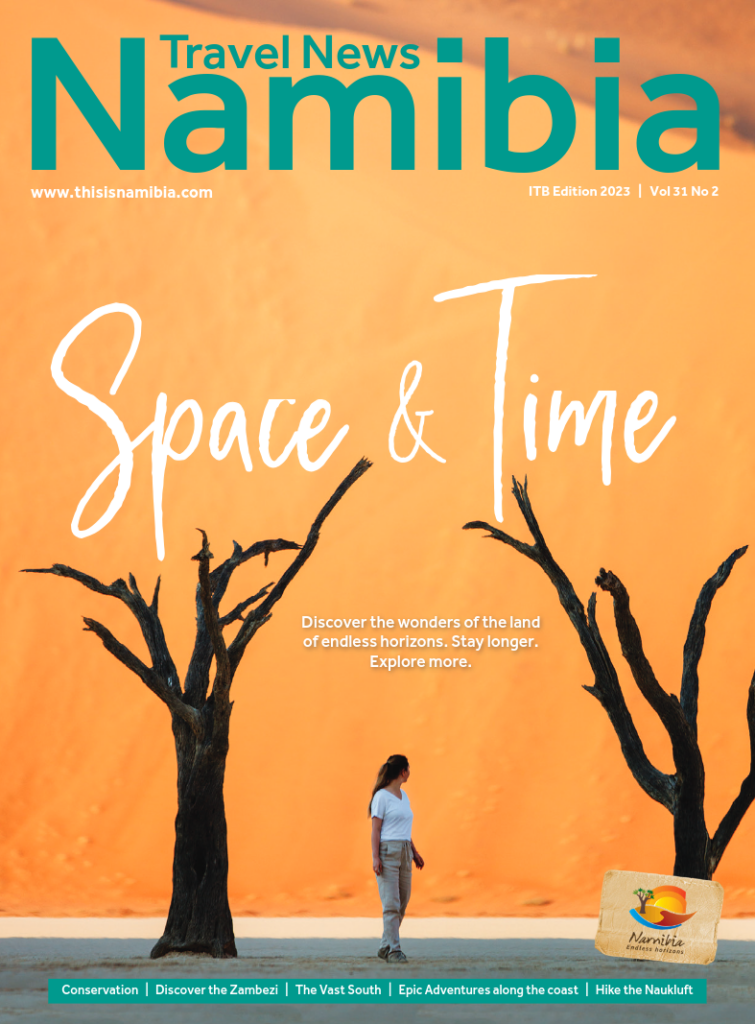

Space & Time
Untouched landscapes spanning as far as the eye can see. An abundance of wildlife roaming free, as nature intended, over bushveld, desert and wetland. A world of birds brimming with sought-after endemic species, found nowhere else on the planet. To the novice this may seem like scenes from the Lion King. In Namibia it is commonplace. This enigmatic land – its fauna, flora and cultures – is no fable from a children’s book. Namibia is rugged, soulful, liberating and natural. Namibia is real, to be touched and treaded lightly, breathed into the crevices of your being, seen, smelled and savoured in a way only time and space can allow.
Text Charene Labuschagne
From the ITB 2023 issue
In Namibia we say that once the sand of the world’s oldest desert has filled your shoes, it will remain there forever. Because there is so much to explore, from the parched plains of the deep south, to the fruitful forests of the north and every awe-inspiring vista in between. It seems impossible to trek the second-least populated country in the world in the span of a two-week holiday. It is possible, but rushing through Namibia is not recommended. This is why lovers of Namibia return to this vast country time and time again. And why locals take their time on long weekends to cover only a small nook of Namibia. They do so to mindfully embrace every precious moment, every exhilarating bird sighting ticked off the list, every technicolour sunset, every dusty gravel road negotiated at a snail’s pace. This is how Namibia is intended to be experienced – thoroughly and without hurry.
Right hand held flat, thumb outstretched and index finger folded, that is the shape of Namibia, perhaps the only country the world over that can be indicated with a single hand. Yet, neither our returning guests nor well-travelled locals can truly know Namibia like the back of their hand. Its kaleidoscope of lines, veins, beauty spots and wrinkles is plentiful, but consider this a challenge to uncover, rather than an adventure to be missed.
In the proverbial thumb of Namibia, the Zambezi and Kavango regions, time becomes irrelevant and existence unhurried. The northernmost part of Namibia will pleasantly surprise perceptions of a desert country. Perennial rivers outline these regions and are an essential part of the local lifestyle. Caprivians and Kavango people engage in fishing and farming, both produce and livestock, on the bountiful banks of the waterways – the Kwando, Linyanti, Chobe and Zambezi as well as the Okavango in the Kavango East and West regions.
Undoubtedly one of the most enriching wildlife experiences can be had in the northeast of Namibia. Here, our plains game and big cats meet the river residents: hippo, crocodile and migrating elephant. Paired with an impressive array of birds like the Carmine Bee-eater and African Fish Eagle, this makes for unforgettable sightings. A river cruise, at a leisurely pace, is the only way to truly savour the wonderland that defines the Zambezi and Kavango regions. Boats are obliged to move slowly, so as not to disrupt hippos and crocodiles, or the locals who navigate the rivers with their mokoro or watu (hand- carved canoes). They have no engine and are manoeuvred with paddles or long poles. The fishermen take their time to position their nets perfectly. Great is the reward of a few small fish for their family’s dinner. Young men attentively herd cattle and goats alongside the streams, and gardens guarded by thick thornbush promise fresh tomatoes in due time.
In a country such as Namibia, in its regions like Zambezi and Kavango where time is not of the essence, patience rewards the unhurried traveller. Just like the Kwando, Linyanti, Chobe, Zambezi and Okavango rivers move slowly yet forcefully, so should a visit to their tributaries and streams be approached with patience, as if waiting for the crop to grow, the cattle to feed and calf, and the fish to bite.
Travelling southwest from the Zambezi Region to Etosha National Park is on a long winding road. More time spent on some of the best-maintained roads in Africa leads to another remarkable wildlife wonder within the borders of Namibia. Favoured and well-photographed for the contrasts against its white expanses, dotted with mopane and acacia trees and boasting an abundance of birds, antelope, black and white rhino, elephant and elusive big cats, Etosha National Park needs little introduction. This is yet another place where more time is spent well.
Due to the speed limit within the park, a slower pace is not only mandatory, it is favourable. Switch off the car engine, let the stark-white dust settle, and then you wait. The very best place to become unhurried is at a waterhole in Etosha, where good things truly come to those who wait. The longer you sit and stare through a pair of binoculars, camera viewfinder, paging through a copy of Roberts Bird Guide or Travel News Namibia, animal sightings favour the patient. Just a moment longer and you might witness a waterhole quarrel between lion and rhino, or a giraffe finally mustering the courage to bend down for a drink. Direct your gaze towards the trees and perhaps spot a brilliantly camouflaged owl nest, an Anchieta’s cobra or even a stealthy cheetah lying in wait for her turn. You can pick up the subtle nuances of animal behaviour only if you unhurry yourself.
While a journey through Etosha National Park can easily take up at least a week of a traveller’s itinerary, there is so much more of Namibia’s 824,292 km² to uncover. Part and parcel of the joy of experiencing Namibia are the seemingly endless roads, like the map of lines on the back of our hands. Take the road less travelled and discover that not a single car may pass you by for kilometres on end. This is just a taste of the infinite expanses, the soul-shaking space that is Namibia.
The region northwest of Etosha is arguably one of the most rugged, untouched landscapes on the continent: Kaokoland. Dissected by dry rivers lined by jackalberry, Ana and fever trees, and characterised by jagged mountain landscapes, deserted plains dotted with sharp outcrops and some of the last, authentic strongholds of the Ovahimba people. Those who dare to venture to this forlorn place will be rewarded with solitary space, enough of it to circumvent the earth and reach your soul.
Before entering Kaokoland, travellers must stock up on sufficient amounts of food, fuel and water to be self- sustainable for the duration of the trip. In its area of over 40,000 km² there is little to no cellphone reception, and the small shops in the heart of Kaokoland sell only the essentials – porridge and beer. Absolute bliss for the claustrophobic and for travellers in search of untamed adventure. The only sentient life in this furrowed landscape is a population of free-roaming desert-adapted elephant and lion and sparsely scattered giraffe, Hartmann’s mountain zebra, gemsbok and springbok. This seemingly inhospitable part of Namibia is also home to groups of traditionally nomadic Ovahimba people who still live in small villages with pastoral livestock and subsistence gardens, much like their ancestors did. Other than the occasional passerby on a similar thrilling adventure, the Ovahimba are the only people who share the expanse with travellers. Even their villages are spread over the vast stretches of Kaokoland. Space can be savoured by travelling through it, as much as it can by staying still. Build a shelter and call it home. With so much space, and enough time to absorb it, comes an inherent appreciation for the fauna, flora and people that inhabit it.
Save the air conditioning for another day, roll down your windows because there are no other vehicles to stir up dust, and breathe in the rolling hills, dales, riverbeds and distant peaks. The insurmountable landscape, the jeep track and the dizzying amount of space – they belong only to you, and the occasional Ovahimba village.
The south of Namibia has yet another example of perfectly uninhabited expanses – Namib-Naukluft National Park. Silk-like dunes in crescent and star shapes, burnt orange plains and valleys, boulders and bergs. They all beckon to be admired. This liberating landscape was formed over aeons, and continues to shift. Around every corner is more of sublime nothing. Peer into forever, traverse it a little at a time, just to discover there is even more nothing beyond. Beside a campfire, under a brilliant belt in the Milky Way, this is where the space enfolds you, just enough to give your mind some much-needed room. Not to think. Leave that for the flight home. In the Namib, all that space, a lonesome gemsbok and occasional plant is what fills your mind, body and soul.
With whoever or however you go about it, provided you unhurry and let the vastness permeate you, a journey through this enigmatic land is bound to be a beautiful celebration of space and time well spent. TNN






